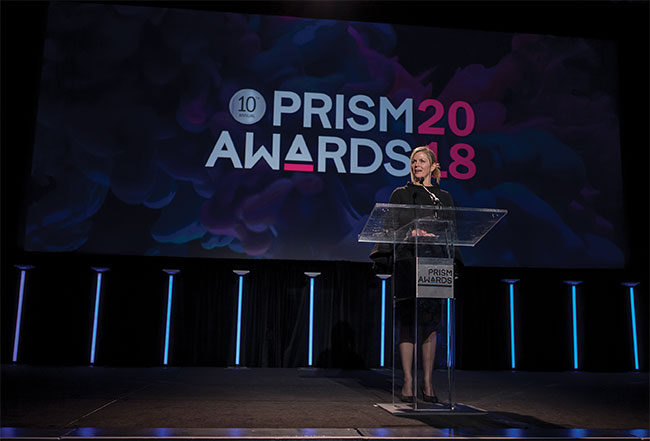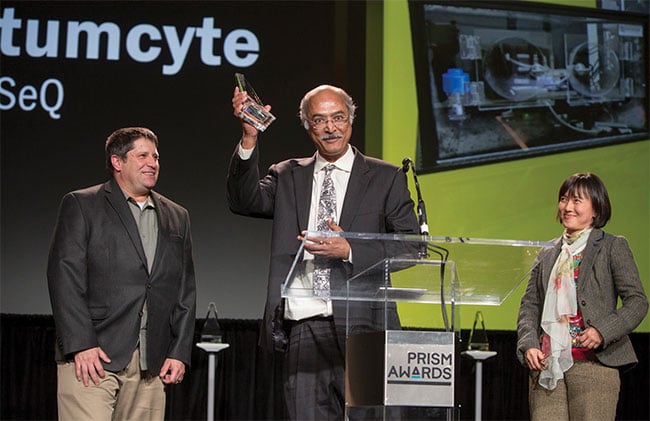The Prism Awards for Photonics Innovation bring anticipation and excitement each year to the Photonics West exhibition in San Francisco. Renowned as the “Oscars of the photonics industry,” the Prism Awards shine a spotlight on some of the industry’s most innovative products and technologies developed by companies from around the world.
“For more than a decade now, the Prism Awards have recognized the people and companies that are driving the remarkable pace of product innovation and technology application in our burgeoning field,” said Thomas Laurin, president and CEO of Laurin Publishing Co.

Pamela Robertson, industry program manager at SPIE, speaks at the 2018 Prism Awards.
The awards, cosponsored by SPIE and Photonics Media (a division of Laurin Publishing Co.), honor the best of the best industrywide in various fields — from
diagnostics and imaging to scientific lasers and optomechanics.
“This year’s Prism finalists represent the savviest and most innovative companies from the growing optics and photonics industry,” said SPIE CEO, Kent Rochford. “The benefits that photonics provides to society are more critical than ever, and the products showcased by the Prism Awards mark an exciting glimpse into the high-level and wide-ranging accomplishments in the field.”
Three finalists are chosen within each of 10 categories, five of which relate to the biophotonics realm.
Detectors and Sensors
Hamamatsu Corp. (New Jersey, U.S.) is a finalist for its C14384MA minispectrometer (SMD series), an extremely small — measuring a little wider than 1 cm — grating-based shortwave-NIR spectral sensor head that is designed and fabricated through MOEMS technology. It features an input slit of 20 µm, which allows incoming light to be dispersed by a nanoimprinted reflective grating and imaged onto a custom CMOS active-pixel image sensor. The C14384MA is the newest relative of Hamamatsu’s microspectrometer technology, which received a Prism Award in 2015.

Darius Sankey, venture capitalist and co-president at Ocean Tomo, presents the 2018 Prism Award in the Environmental Monitoring category.
ImpactVision (San Francisco) is also vying for the top honor in this category with its Real-Time Food Quality Decisions software. It gathers hyperspectral data from any source and provides information about any form of food item using computer vision algorithms. The software provides insights about the quality of foods — including the freshness of fish, the ripeness of avocados, and the presence of foreign objects — noninvasively and rapidly at production-grade speeds. This enables food companies to shift from using destructive sample tests to using a fully automated system that provides 100 percent product coverage.
Diagnostics and Therapeutics
In this category, Convergent Dental (Massachusetts, U.S.) presents Solea, a CO2 9.3-μm dental laser that can replace anesthesia and invasive procedures. It vaporizes hard tissue quickly and smoothly, while also performing soft-tissue procedures. The technology essentially manipulates the laser energy into patterns that help obtain a rapid analgesic effect, optimizes cutting speed with minimal energy delivery, and controls hemostasis in a predictable manner.
The SPINDLE nanoimaging system, by Double Helix Optics (Colorado, U.S.), enables superresolution 3D imaging with unparalleled depth and axial precision. SPINDLE’s extended-depth imaging allows for the study of cellular structures down to the single-molecule level in 3D. The technology, which can be installed on microscopes, captures high-precision, superresolution 3D images across a large depth of field. This enables collection of significantly more data in a single shot (up to 20 μm).

Bidhan Chaudhuri, founder and chief technology officer of QuantumCyte, accepts the 2018 Prism Award in the Life Science and Instrumentation category along with John Butler, CEO (left), and Bernadine Lim, vice president of international business development.
The RedShift BioAnalytics Inc. (Massachusetts, U.S.) AQS3pro protein analyzer is an automated multisample tool using laser-based technology. It measures for key protein biophysical characteristics, including aggregation, quantitation, stability, similarity, and structure, and analyzes the biophysical structure of protein therapeutic drugs using microfluidic modulation spectroscopy. This device touts a measurable protein concentration range of 0.1 to over 200 mg/mL, a 30× improvement in sensitivity over FTIR.
Optics and Optomechanics
The DOF-5 objective focuser by finalist Dover Motion (Massachusetts, U.S.) is a nanopositioning stage optimized for optical imaging applications. It features brushless linear motor technology, stiff cross-roller guide rails, optical encoder position feedback, and a motion controller that provides a hardware interface requiring only power and communication signals. The DOF-5 features a configurable objective mount with different adapter thread options, and can be mounted in multiple locations on a stage and be oriented in a regular or an inverted setup.
Nikon (Tokyo) and its 4D Free-form SG (silica glass, which is composed largely of silicon dioxide) are also among the finalists. This technology allows shaping freely, as with resin materials, and also possesses the properties of silica glass — high transmittance, high laser and chemical durability, and high heat resistance. The Free-form SG can replace optical glass and resin lenses, which, in turn, increases performance and extends the life of optical instruments.
Scientific Lasers
Chromacity (Edinburgh, Scotland) is a finalist for its OPO-CX, a compact, highly stable ultrafast optical parametric oscillator. It touts a high-pulse repetition frequency (widths of 1 to 2 ps at 100 MHz) that delivers ultrashort pulses across the NIR range (1.48 to 4.2 μm) for both imaging and spectroscopy. It features a fully integrated pump source, and generates average powers up to 800 mW from a signal port and 350 mW from an idler port. The OPO-CX assists high-impact research.
The ALCOR 920 nm/2W by Spark Lasers (Martillac, France) is an ultracompact, sub-140-fs, fiber-based laser source. It operates at a fixed frequency of 80 MHz at 920 nm, targets two-photon imaging applications for neuroscience at <140 fs, and provides a smaller footprint than traditional Ti:sapphire lasers. The system features high average power and high peak power (up to 250 kW), as well as a mounting scheme that allows users to mount the laser directly on a microscope (or as close as possible).
Finalist product DLC TOPO by TOPTICA Photonics Inc. (New York) is a widely tunable MIR laser source. This continuous-wave laser allows automated, hands-free, high-power, tunable access to MIR wavelengths in the 1.45- to 4.0-μm range. Existing laser systems include a manual interface, and they typically require multiple parallel modules to access this broad wavelength range. The DLC TOPO is fully automated and its functionality does not require additional modules.
Vision Technology
The Optotune (Dietikon, Switzerland) XPR-25 is an extended pixel resolution four-position actuator. This finalist technology features a clear aperture of approximately 25 mm and enables image resolution to be increased from its native 1080p to 4K. It uses reluctance force to allow average transition times of 1.2 ms (abs max 1.5 ms), resulting in a complete shift, specifically during the short time a blue image is shown (human eyes have the lowest resolution in blue). With an optimized drive signal and mechanical decoupling, sound pressure at 1 m is 21 dBA (abs max 25 dBA), which produces silent end products.
The RETISSA Display from QD Laser Inc. (Kanagawa, Japan) is retinal projection laser eyewear that includes an optical see-through, head-mounted display device. It uses a miniature laser projector to draw images directly to the wearer’s retina; laser scanning retinal projection is employed with the combination of an RGB semiconductor laser and a MEMS mirror. The display technology produces high-resolution images with precise control of laser beams and touts a natural appearance in which all optics are integrated inside the frame, allowing the eyewear to look like conventional sunglasses.
For a complete list of the 2019 Prism Award finalists, visit www.photonicsprismaward.com/finalists.aspx.